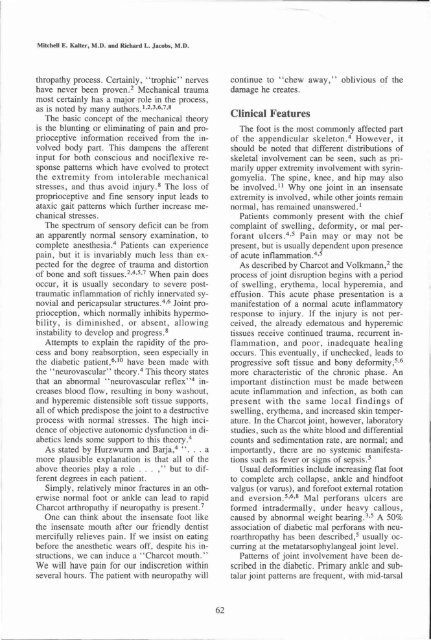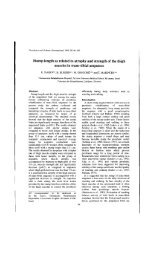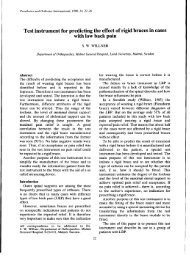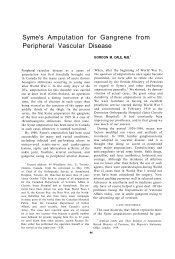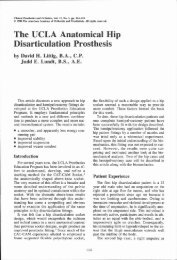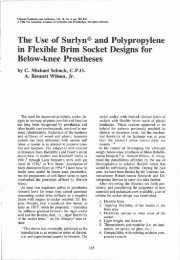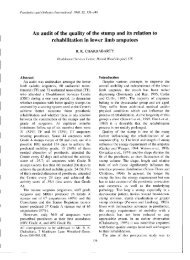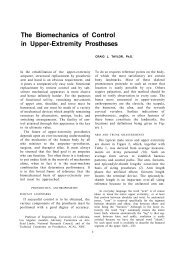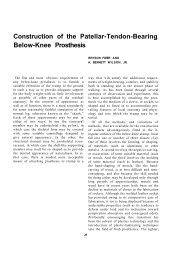Pro-Corn - O&P Library
Pro-Corn - O&P Library
Pro-Corn - O&P Library
Create successful ePaper yourself
Turn your PDF publications into a flip-book with our unique Google optimized e-Paper software.
thropathy process. Certainly, "trophic" nerves<br />
have never been proven. 2<br />
Mechanical trauma<br />
most certainly has a major role in the process,<br />
as is noted by many authors. 1,2,3,6,7,8<br />
The basic concept of the mechanical theory<br />
is the blunting or eliminating of pain and proprioceptive<br />
information received from the involved<br />
body part. This dampens the afferent<br />
input for both conscious and nociflexive response<br />
patterns which have evolved to protect<br />
the extremity from intolerable mechanical<br />
stresses, and thus avoid injury. 8<br />
The loss of<br />
proprioceptive and fine sensory input leads to<br />
ataxic gait patterns which further increase mechanical<br />
stresses.<br />
The spectrum of sensory deficit can be from<br />
an apparently normal sensory examination, to<br />
complete anesthesia. 4<br />
Patients can experience<br />
pain, but it is invariably much less than expected<br />
for the degree of trauma and distortion<br />
of bone and soft tissues. 2,4,5,7<br />
When pain does<br />
occur, it is usually secondary to severe posttraumatic<br />
inflammation of richly innervated synovial<br />
and pericapsular structures. 4,6<br />
Joint proprioception,<br />
which normally inhibits hypermobility,<br />
is diminished, or absent, allowing<br />
instability to develop and progress. 8<br />
Attempts to explain the rapidity of the process<br />
and bony reabsorption, seen especially in<br />
the diabetic patient, 6,10<br />
have been made with<br />
the "neurovascular" theory. 4<br />
This theory states<br />
that an abnormal "neurovascular reflex" 4<br />
increases<br />
blood flow, resulting in bony washout,<br />
and hyperemic distensible soft tissue supports,<br />
all of which predispose the joint to a destructive<br />
process with normal stresses. The high incidence<br />
of objective autonomic dysfunction in diabetics<br />
lends some support to this theory. 4<br />
As stated by Hurzwurm and Barja, 4<br />
". . . a<br />
more plausible explanation is that all of the<br />
above theories play a role . . . ," but to different<br />
degrees in each patient.<br />
Simply, relatively minor fractures in an otherwise<br />
normal foot or ankle can lead to rapid<br />
Charcot arthropathy if neuropathy is present. 7<br />
One can think about the insensate foot like<br />
the insensate mouth after our friendly dentist<br />
mercifully relieves pain. If we insist on eating<br />
before the anesthetic wears off, despite his instructions,<br />
we can induce a "Charcot mouth."<br />
We will have pain for our indiscretion within<br />
several hours. The patient with neuropathy will<br />
continue to "chew away," oblivious of the<br />
damage he creates.<br />
Clinical Features<br />
The foot is the most commonly affected part<br />
of the appendicular skeleton. 4<br />
However, it<br />
should be noted that different distributions of<br />
skeletal involvement can be seen, such as primarily<br />
upper extremity involvement with syringomyelia.<br />
The spine, knee, and hip may also<br />
be involved. 11<br />
Why one joint in an insensate<br />
extremity is involved, while other joints remain<br />
normal, has remained unanswered. 1<br />
Patients commonly present with the chief<br />
complaint of swelling, deformity, or mal perforant<br />
ulcers. 4,5<br />
Pain may or may not be<br />
present, but is usually dependent upon presence<br />
of acute inflammation. 4,5<br />
As described by Charcot and Volkmann, 2<br />
the<br />
process of joint disruption begins with a period<br />
of swelling, erythema, local hyperemia, and<br />
effusion. This acute phase presentation is a<br />
manifestation of a normal acute inflammatory<br />
response to injury. If the injury is not perceived,<br />
the already edematous and hyperemic<br />
tissues receive continued trauma, recurrent inflammation,<br />
and poor, inadequate healing<br />
occurs. This eventually, if unchecked, leads to<br />
progressive soft tissue and bony deformity, 5,6<br />
more characteristic of the chronic phase. An<br />
important distinction must be made between<br />
acute inflammation and infection, as both can<br />
present with the same local findings of<br />
swelling, erythema, and increased skin temperature.<br />
In the Charcot joint, however, laboratory<br />
studies, such as the white blood and differential<br />
counts and sedimentation rate, are normal; and<br />
importantly, there are no systemic manifestations<br />
such as fever or signs of sepsis. 5<br />
Usual deformities include increasing flat foot<br />
to complete arch collapse, ankle and hindfoot<br />
valgus (or varus), and forefoot external rotation<br />
and eversion. 5,6,8<br />
Mal perforans ulcers are<br />
formed intradermally, under heavy callous,<br />
caused by abnormal weight bearing. 3,5 A 50%<br />
association of diabetic mal perforans with neuroarthropathy<br />
has been described, 5<br />
usually occurring<br />
at the metatarsophylangeal joint level.<br />
Patterns of joint involvement have been described<br />
in the diabetic. Primary ankle and subtalar<br />
joint patterns are frequent, with mid-tarsal


